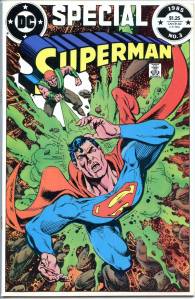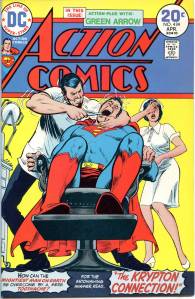In 1984, editor Len Wein assigned Swamp Thing to British writer Alan Moore. When Karen Berger took over as editor, she gave Moore free rein to revamp the title and the character as he saw fit. Moore reconfigured Swamp Thing’s origin to make him a true monster as opposed to a human transformed into a monster. In his first issue, he swept aside most of the supporting cast Pasko had introduced in his year-and-a-half run as writer, and brought the Sunderland Corporation to the forefront, as they hunted Swamp Thing and “killed” him in a hail of bullets. The subsequent investigation revealed that Swamp Thing was not Alec Holland’s consciousness transformed into a plant but actually a form of plant life that had absorbed Holland’s consciousness after exposure to his work, with Swamp Thing’s appearance being the plants’ attempt to duplicate Holland’s human form.
Category: DC Bronze Age
Time Warp (1979)
In 1978, DC Comics intended to revive its science-fiction anthology series Strange Adventures. These plans were put on hold that year due to the DC Implosion, a line-wide scaling back of the company’s publishing output. When the project was revived a year later, the title was changed to Time Warp and the series was in the Dollar Comics format. The first issue was published with an October–November 1979 cover date. Michael Kaluta provided the cover art for the entire run.
The title featured a mixture of both established comics creators and new talent. The writing team of Dan Mishkin and Gary Cohn made their comics debut in issue #3 with the three-page short story “On the Day of His Return” which was drawn by Steve Ditko.
Time Warp was canceled with issue #5 (June–July 1980) and unused inventory originally intended for the series was published in a revival of the Mystery in Space title. Other Time Warp stories appeared in the mystery anthology The Unexpected.
A one-shot was published by DC’s Vertigo imprint in May 2013. It included a Rip Hunter story by writer Damon Lindelof and artist Jeff Lemire.
The New Teen Titans (1980’s)
In 1980, Teen Titans relaunched as The New Teen Titans, aging the characters to young adulthood. Original members Robin, Wonder Girl and Kid Flash were joined by new characters Cyborg, Starfire and Raven, as well as the former Doom Patrol member Beast Boy, as Changeling. The group had several encounters with the original Titans of Greek mythology, particularly Hyperion.
The team’s adversaries included Deathstroke the Terminator, a mercenary who takes a contract to kill the Titans to fulfill a job his son had been unable to complete. This led to perhaps the most notable Titans storyline of the era. 1984’s “The Judas Contract,” in Tales of the Teen Titans #42-44 and Teen Titans Annual #3 featured a psychopathic girl named Terra with the power to manipulate earth and all earth-related materials. She infiltrates the Titans in order to destroy them. “The Judas Contract” won the Comics Buyer’s Guide Fan Award for “Favorite Comic Book Story” of 1984, and was later reprinted as a standalone trade paperback in 1988. Robin adopts the identity of Nightwing, while Wally West gives up his Kid Flash persona and quits the Titans. It also featured the introduction of a new member in Jericho, Deathstroke’s other son.
Shazam (1973)
When superhero comics became popular again in the mid-1960s in what is now called the “Silver Age of Comic Books“, Fawcett was unable to revive Captain Marvel, having agreed to never publish the character again as part of their 1953 settlement. Looking for new properties to introduce to the DC Comics line, DC publisher Carmine Infantino decided to bring the Captain Marvel property back into print. On June 16, 1972, DC entered into an agreement with Fawcett to license the Captain Marvel and Marvel Family characters. Because Marvel Comics had by this time established Captain Marvel as a comic book trademark for their own character, created and first published in 1967, DC published their book under the name Shazam! Infantino attempted to give the Shazam! book the subtitle The Original Captain Marvel, but a cease and desist letter from Marvel Comics forced them to change the subtitle to The World’s Mightiest Mortal, starting with Shazam! #15 (December 1974). As all subsequent toys and other merchandise featuring the character have also been required to use the “Shazam!” label with little to no mention of the name “Captain Marvel”, the title became so linked to Captain Marvel that many people took to identifying the character as “Shazam” instead of “Captain Marvel”
Superman V1 (1980’s)
The 1980s saw radical revisions of Superman. DC decided to remove the multiverse in a bid to simplify its comics line. This led to the rewriting of the back story of the characters DC published, Superman included. John Byrne rewrote Superman, removing many established conventions and characters from continuity, including Superboy and Supergirl. Byrne also re-established Superman’s adoptive parents, The Kents, as characters. In the previous continuity, the characters had been written as having died early in Superman’s life (about the time of Clark Kent’s graduation from high school).
Detective Comics (1970’s)
Writer Dennis O’Neil and artist Neal Adams had their first collaboration on Batman on the story “The Secret of the Waiting Graves” in issue #395 (Jan. 1970). The duo, under the direction of Schwartz, would revitalize the character with a series of noteworthy stories reestablishing Batman’s dark, brooding nature and taking the books away from the campy look and feel of the 1966–68 ABC TV series. Comics historian Les Daniels observed that “O’Neil’s interpretation of Batman as a vengeful obsessive-compulsive, which he modestly describes as a return to the roots, was actually an act of creative imagination that has influenced every subsequent version of the Dark Knight.” Adams introduced the Man-Bat with writer Frank Robbins in Detective Comics #400 (June 1970). O’Neil and artist Bob Brown crafted Batman’s first encounter with the League of Assassins in Detective Comics #405 (Nov. 1970) and created Talia al Ghul in issue #411 (May 1971).
After publishing on a monthly schedule throughout its run, Detective Comics became a bi-monthly book from issues #435 (June–July 1973) to #445 (Feb.-March 1975). Issues #438 (Dec. 1973-Jan. 1974) to #445 (Feb.–March 1975) of the series were in the 100 Page Super Spectacular format. O’Neil and artist Dick Giordano created the Batman supporting character Leslie Thompkins in the story “There Is No Hope in Crime Alley” appearing in issue #457 (March 1976). Writer Steve Englehart and artist Marshall Rogers produced an acclaimed run of Batman stories in Detective Comics #471–476 (Aug. 1977 – April 1978), and provided one of the definitive interpretations that influenced the 1989 Batman movie and would be adapted for the 1990s animated series. The Englehart and Rogers pairing, was described in 2009 by comics writer and historian Robert Greenberger as “one of the greatest” creative teams to work on the Batman character. In their story “The Laughing Fish”, the Joker is brazen enough to disfigure fish with a rictus grin, then expects to be granted a federal trademark on them, only to start killing the bureaucrats who try to explain to him that obtaining such a claim on a natural resource is legally impossible. Writer Len Wein and Rogers co-created the third version of the supervillain Clayface in Detective Comics #478 (July–Aug. 1978). The original Katherine Kane also known as “Batwoman” was killed in the lead story in issue #485 (Aug.–Sept. 1979) by the League of Assassins.
Vigilante (1983)
Vigilante was an ongoing series published from November of 1983 to February 1988. The series featured the honorable Adrian Chase, who was first introduced in the pages of New Teen Titans Annual #2. Spanning a total of fifty issues and two Annuals, the series ended with the death of the main character.
DC Comics Presents V1 (1978)
DC Comics Presents debuted with a July/August 1978 cover date . The series was launched with a team-up of Superman and the Flash by writer Martin Pasko and artist José Luis García-López. Issue #26 included an insert introduction story to the then-upcoming New Teen Titans series by Marv Wolfman and George Pérez. Len Wein and Jim Starlin co-created the supervillain Mongul in issue #27 (Nov. 1980) as part of a three-issue storyline. Another insert in issue #41 previewed the “new direction” Wonder Woman. In issue #47, Superman traveled to Eternia and met the Masters of the Universe. Ambush Bug made his first appearance in issue #52 (Dec. 1982) and made additional appearances in issue #59 and #81. The Superman/Challengers of the Unknown tale in issue #84 was drawn by Jack Kirby and Alex Toth. The series also contained the Alan Moore Superman/Swamp Thing story “The Jungle Line” in DC Comics Presents #85 (Sept. 1985), pencilled by Rick Veitch and inked by Al Williamson. Issue #87 featured the first appearance and origin of the divergent Kal-El of the Earth Prime reality, who would become known as Superboy-Prime. The final issue is an exception to the team-up format, instead featuring Superman in an “Untold Tale” involving the Phantom Zone, by Steve Gerber, following up in his limited series of the same title.
Batman (1970’s)
Starting in 1969, writer Dennis O’Neil and artist Neal Adams made a deliberate effort to distance Batman from the campy portrayal of the 1960s TV series and to return the character to his roots as a “grim avenger of the night”. O’Neil said his idea was “simply to take it back to where it started. I went to the DC library and read some of the early stories. I tried to get a sense of what Kane and Finger were after.”
O’Neil and Adams first collaborated on the story “The Secret of the Waiting Graves” (Detective Comics #395, January 1970). Few stories were true collaborations between O’Neil, Adams, Schwartz, and inker Dick Giordano, and in actuality these men were mixed and matched with various other creators during the 1970s; nevertheless the influence of their work was “tremendous”. Giordano said: “We went back to a grimmer, darker Batman, and I think that’s why these stories did so well…” While the work of O’Neil and Adams was popular with fans, the acclaim did little to improve declining sales; the same held true with a similarly acclaimed run by writer Steve Englehart and penciler Marshall Rogers in Detective Comics #471–476 (August 1977 – April 1978), which went on to influence the 1989 movie Batman and be adapted for Batman: The Animated Series, which debuted in 1992. Regardless, circulation continued to drop through the 1970s and 1980s, hitting an all-time low in 1985.
Action Comics (1970’s)
Mort Weisinger retired from DC in 1970 and his final issue of Action Comics was issue #392 (September 1970). Murray Boltinoff became the title’s editor until issue #418. Metamorpho was the backup feature in issues #413-418 after which the character had a brief run as the backup in World’s Finest Comics. Julius Schwartz became the editor of the series with issue #419 (December 1972) which also introduced the Human Target by Len Wein and Carmine Infantino in the back-up feature. Green Arrow became a backup feature in #421 and ran through #458, initially rotating with the Human Target and the Atom. Between issues #423 (April 1973) and #424 (June 1973), the series jumped ahead by one month due to DC’s decision to change the cover dates of its publishing line.
A new version of the Toyman was created by Cary Bates and Curt Swan in issue #432 (February 1974). Martin Pasko wrote issue #500 (October 1979) which featured a history of the Superman canon as it existed at the time and was published in the Dollar Comics format.






















































































































































































































